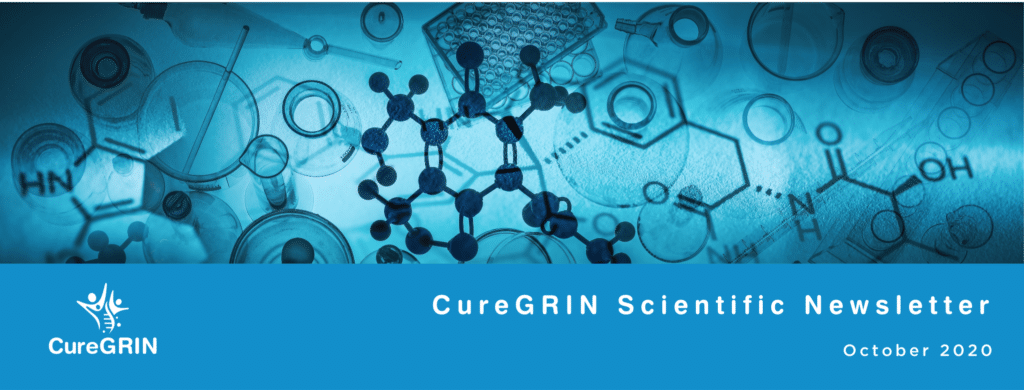CureGRIN Scientific Newsletter – Oct 2020
Share This Post

Welcome to the second edition of CureGRIN Foundation’s scientific newsletter.
Every two months, we’ll continue to share updates on the latest publications about GRIN genes, NMDA receptors and other glutamate receptors. We’ll also be talking about new developments in seizure treatments and other GRIN symptoms.
In this second edition, CureGRIN’s research coordinator, Meagan Collins summarizes the findings of three recent peer-reviewed scientific research articles. First, we discuss an article published in Molecular Psychiatry and learn about rescuing NMDA receptor functioning in mice. We then discuss an article published in Cell Reports describing the effects of a GluN2A-S1459G variant associated with epilepsy. Finally, we discuss the findings of an article published in Epilepsy Research discussing the potential for immunotherapy.
Can NMDA receptor functioning be improved in adults?
Researchers at the University of Toronto investigated whether the functioning of NMDA receptors could be improved in adult GRIN1 knockdown mice using gene editing with Cre recombinase. The GRIN1 gene encodes GluN1, a vital subunit of the NMDA receptor. A team led by Dr. Amy Ramsey, a member of CureGRIN’s scientific advisory board, generated a global Grin1 loss-of-function mouse model using Cre-Lox recombination. These mice were crossed with Rosa26-CreERT2 mice. Then, the mice were given tamoxifen for restoring the wildtype allele through Cre recombination (Grin1RESCUE). After the gene editing intervention, the researchers assessed Grin1 gene expression levels, NMDA receptor activity, and cognition in the Grin1RESCUE mice. They found that they were able to rescue both mRNA and NMDA receptor protein complex in the prefrontal cortex in the rescue mice, and they were able to rescue current of the NMDA receptors. Additionally, the researchers were able to rescue cognitive function in the Grin1RESCUE mice, as assessed by numerous behavioral tests, including habituation to novelty, sensorimotor gating, executive function, and social investigation. The findings were published in the scientific journal Molecular Psychiatry.
In summary, the researchers found that they were able to achieve remarkable recovery in adulthood for the Grin1RESCUE mice, demonstrating cortical plasticity of the adult brain. Moreover, this research provides exciting new revelations for the potential of effective therapeutic intervention for adult GRIN-disorder patients in the future.
To learn more, check out our recent blog post and interview of Dr. Amy Ramsey and Dr. Catharine Mielnik and visit: Mielnik CA, Binko MA, Chen Y, et al. Consequences of NMDA receptor deficiency can be rescued in the adult brain [published online ahead of print, 2020 Aug 17]. Mol Psychiatry. 2020;10.1038/s41380-020-00859-4. doi:10.1038/s41380-020-00859-4.
How does phosphorylation affect the NMDA receptor in patients with GRIN2A variants?
In this article published in the scientific journal Cell Reports, Dr. Katherine Roche, a member of CureGRIN’s scientific advisory board, and her colleagues, demonstrate the functional effects of a de novo GRIN2A variant, which was identified in a patient diagnosed with epilepsy and moderate intellectual disability. This rare variant, GRIN2A c.4375A>G, results in the GluN2A-S1459G missense variant.
The researchers found that the GluN2A-S1459 variant acts as a phosphorylation site of the kinase CaMKIIα. Phosphorylation is a key form of post-translational modification, whereby a phosphate group is added to a molecule, altering the structural conformation of the protein. Furthermore, the researchers found that the GluN2A-S1459 variant affects protein-protein interactions of the NMDA receptors. This variant also affects receptor trafficking and demonstrates a defect in excitatory transmission. This particular variant likely results in NMDA receptor hypofunction, suggesting that the phenotype of the patient is due to reduced trafficking and signaling in the NMDA receptors containing GluN2A.
This research is important because most of the variants that have been functionally tested thus far affect residues in the agonist binding and channel domains of NMDA receptors, resulting in a loss-of-function or gain-of-function, yet there has been little functional testing of variants located in the intracellular domain of the NMDA receptor subunits.
To learn more visit: Mota Vieira M, Nguyen TA, Wu K, et al. An Epilepsy-Associated GRIN2A Rare Variant Disrupts CaMKIIα Phosphorylation of GluN2A and NMDA Receptor Trafficking. Cell Rep. 2020;32(9):108104. doi:10.1016/j.celrep.2020.108104
Could immunotherapy be used as a potential treatment?
An article published in the scientific journal Epilepsy Research provides preliminary data and evaluates the efficacy of intravenous immunoglobulin (IVIG) treatment given to four patients with GRIN2A-related disorder and one patient with GRIN2D-related disorder. IVIG is an immunomodulatory treatment comprised of blood product created from the serum of donors. Each patient received a monthly infusion of IVIG (2 mg/kg/day divided into 2 days) for 6 months, except for one patient who discontinued treatment at 3 months. Two of the patients were treated with high-dose corticosteroids as well.
Three of the patients (2 males, 1 female) are siblings with a familial loss-of-function GRIN2A c.2041C > T p.Arg681* variant. One male patient presented with a de novo GRIN2D c.1999G>Ap. (Val667Ile) gain-of-function variant. One additional male patient presented with a de novo GRIN2A c.1639_1641del, p.Ser547del loss-of-function variant.
Some positive improvements were observed in the patients following IVIG treatment. For the four patients who completed the 6 months of treatment, there was an electrographical improvement, with EEG normalization or near normalization in three of the patients. There were also some clinical improvements noted in the patients, including increased verbal abilities and communication skills in two of the patients with GRIN2A variants. The clinical improvements observed corresponded with a reduction in spike frequency on serial EEGs. However, all patients still had marked developmental deficits and intellectual disability after immunotherapy. It will be necessary to have additional studies in the future to validate the efficacy of this treatment for GRIN-related disorders.
To learn more visit: Hausman-Kedem M, Menascu S, Greenstein Y, Fattal-Valevski A. Immunotherapy for GRIN2A and GRIN2D-related epileptic encephalopathy. Epilepsy Res. 2020 Jul;163:106325. doi: 10.1016/j.eplepsyres.2020.106325. Epub 2020 Apr 2. PMID: 32289570.
About Us
This newsletter is assembled by CureGRIN Foundation. Our goal is to find cures and therapies for people around the world living with disease-causing GRIN gene variants. We know that for this to happen, clinicians, researchers, biotech companies and patient advocates need to collaborate. We want to accomplish these goals with your help! Contact me here.
Keith
Keith McArthur, Chief Executive Officer and Head of Science
CureGRIN Foundation
www.curegrin.org
keith@curegrin.org
Contact Us
CureGRIN Foundation
5732 Regal Oak Lane
Parker, Colorado 80134
(303) 881-3425
Read more Posts

Rare Disease Day
Join us and #lightupforrare on Rare Disease Day, February 29! Light up in solidarity with over 300 million people living with a rare condition and share our colors.

